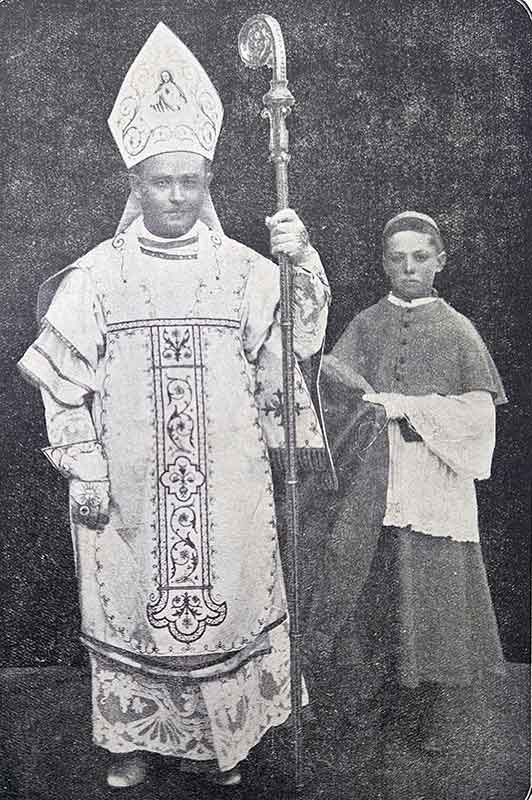David O’Leary OMI: The First-Ever SA-Born Bishop

Bishop David O’Leary and the May 27, 1925, issue of The Southern Cross which announced his appointment.
When Fr David O’Leary OMI was appointed to head the vicariate of Transvaal in May 1925, he became the first-ever South African-born bishop. Günther Simmermacher dug into the life of a man who helped shape the local Church.
This year marks the 100th anniversary of Pope Pius XI appointing the first South African-born bishop, almost a century after the first prelate took occupancy of a vicariate in the region.
Bishop David O’Leary, a slight-built and fresh-faced 44-year-old Oblates of Mary Immaculate priest, was serving the Catholic community of Bloemfontein when he received the surprising message that he was to head the vicariate of Transvaal, succeeding his confrère Bishop Charles Cox. O’Leary’s appointment came two months before that of another locally-born bishop, Bernard O’Riley, in Cape Town.
In terms of succession, the vicariate of Transvaal is now the archdiocese of Johannesburg, but until the reorganisation of diocesan territories in 1948, it also included Pretoria and other outlying areas.
David O’Leary was born on August 19, 1880, in Kimberley, where his father, John, was a pioneer of the Diamond Fields and a politician, representing Griqualand West in the old Cape House of Assembly.
Devout family
John O’Leary was a devout Catholic from Fermoy in the south of Ireland who as a young man had fought in the US Civil War. Every evening, the family would gather to pray the rosary, the children and mother on their knees, and John in the armchair, owing to a war wound which made kneeling a torture.
Apart from a priest, the family also produced two nuns.
Davie, as the O’Leary family knew him, spent three or four years living with his grandmother in Fermoy — she predicted that the boy would one day become a bishop. Back in the Cape, he was educated by the Marist Brothers in Uitenhage and at St Aidan’s in Grahamstown, matriculating in 1898.
In 1905, he entered the Oblates’ novitiate in Dublin and later studied in Liège, Belgium, where he was ordained a priest on June 10, 1910.
Returning a year later to South Africa, by now a unified country, he first served for five years in Mafikeng and then in Bloemfontein, where he built a new church in what was still one parish covering much of the Free State. His time there was interrupted by two years as an army chaplain during World War I in German East Africa.
After the war, he became known in Bloemfontein as a “travelling priest”, providing pastoral care to the scattered Catholic community of his vast parish. In the absence of a boys’ school in Bloemfontein, he raised the funds to build one, inviting the Marist Brothers to run it.

Bishop O’Leary, by now retired, at his last public function, blessing the foundation stone of Christ the King cathedral in Johannesburg in June 1958. He died less than two months later at the age of 77.
Historic appointment
His appointment as bishop in May 1925 made news even in the secular press, which took pride in the first locally-born member of the episcopate. Of course, The Southern Cross was even prouder! On its front page of May 27, it reported: “The Southern Cross immediately telegraphed its felicitations and received a reply from the bishop-designate, praying that abundant blessings might attend the mission of The Southern Cross.”
A “Lay Correspondent” from Bloemfontein told the national Catholic weekly’s readers about the new bishop: “Everywhere in Bloemfontein and the Free State, with its scattered towns and struggling dorps, the name of Fr O’Leary is respected and honoured by Catholics and non-Catholics alike. They know him in the town for his genial, fresh-complexioned, almost boyish face and his alert little figure […] Sometimes, you missed him for days, and then you found that he had been driving into the veld among the isolated homes of the Free State, offering the consolation of the faith to some lonely Catholic, sick or dying.”
In keeping with his lifelong devotion to the Virgin Mary, Bishop O’Leary chose her birthday, September 8, for his consecration, presided over by Bishop Henri Delalle of Natal in the presence of the new bishop’s mother.
He then set to work. Within a few months, he founded the Catholic Federation, with the aim of engaging the laity in the work of the Church. With racial separation being a reality in South Africa long before apartheid reared its ugly head, the Catholic Federation was reserved for whites. O’Leary later sponsored the Catholic African Union to do similar work to that of the Federation.
Builder of churches
Bishop O’Leary was a keen builder of missions, starting with St Mary’s in Krugersdorp, financed with the presentation money he had received at his consecration. His 25 years as bishop saw the construction of many churches — including Sacred Heart church in Pretoria, which would become the city’s cathedral in 1953 — to serve a rapidly growing population, and the influx of missionary clergy and religious. The Marist and Christian Brothers opened new schools in the vicariate to meet the needs of the increasing population.
When Bishop O’Leary retired in November 1950, he moved to live in Potchefstroom. His last public appearance was to lay the foundation stone of Johannesburg’s new cathedral of Christ the King on June 29, 1958, bringing to fruition a dream he had long held. Alas, he would never see the beautiful cathedral completed.
Less than two months later, on August 12, 1958, God called home the great South African bishop who did extraordinary work to build the Church, in Bloemfontein and the old Transvaal.
Published in the May 2025 issue of The Southern Cross
- David O’Leary OMI: The First-Ever SA-Born Bishop - August 11, 2025
- Shrines around the World: Our Lady of Lebanon - August 5, 2025
- May Relics Be Sold? - July 22, 2025








